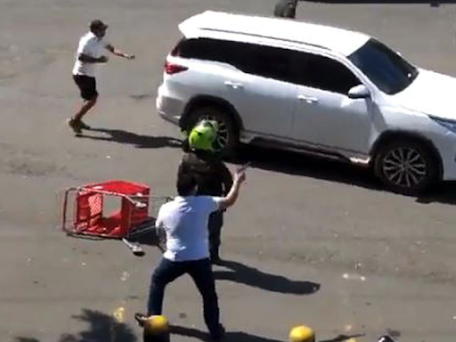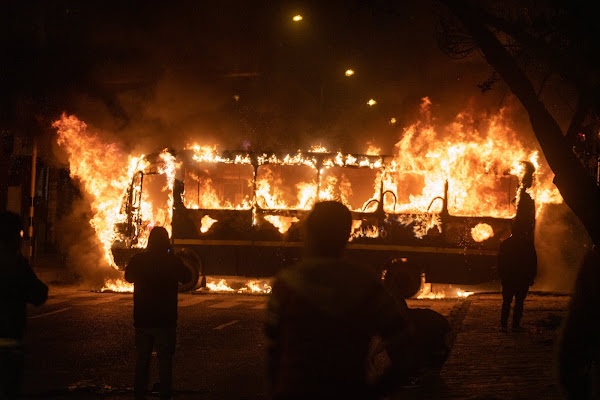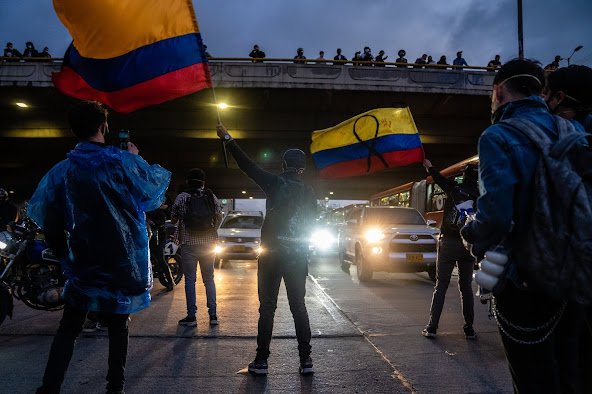Source: https://www.nytimes.com/es/2021/05/05/espanol/protestas-policia-colombia.html?smid=url-share
Colombian police respond to protests with bullets and more deaths
The country, overwhelmed by the crisis and the pandemic, erupts in outrage. At least 24 people have died as the government cracks down on protesters.
A police officer fired tear gas on Wednesday in Bogotá during protests that left at least 24 dead and 87 missing. Credit: Federico Rios for The New York Times
By Julie Turkewitz and Sofía Villamil
May 5, 2021
BOGOTÁ, Colombia - A teenagershot to deathafter kicking a police officer. A young man bleeding in the street as protesters shout for help. Police officersfiringat unarmed protesters. Helicopters flying overhead, tanks sweeping through neighborhoods, explosions echoing through the streets. A mother crying for her child.
"We are destroyed," said Milena Meneses, 39, whose only son, Santiago, 19, was killed in a protest over the weekend.
Colombians who demonstrated last week against the poverty and inequality that have made the lives of millions worse since the COVID-19 pandemic began have faced powerful repression by their government, which has responded to the protests with the same militarized police force that is often deployed against rebel fighters and organized crime.
This explosion of frustration in Colombia, experts say, could herald unrest in Latin America, where several countries face the same explosive combination of a relentless pandemic, mounting hardships and falling government revenues.
"We are all connected," said León Valencia, a political analyst, noting that past protests in Latin America have jumped from one country to another. "This could spread throughout the region."
On Wednesday, after seven days of marches and clashes that turned parts of Colombian cities into battlefields, protesters broke through protective barriers around the nation's Congress and attacked the building before being repelled by police.
Several people from the political party of President Iván Duque ask him to declare a state of internal commotion, an exceptional state that would grant him broad powers.
A group of people were protesting police brutality on a Bogotá street last Wednesday. Credit: Federico Rios for The New York Times
The clashes have left at least 24 people dead, most of them participating in the demonstrations, and at least 87 missing, and have exacerbated anger against officials in the capital Bogotá, who according to many protesters are increasingly disconnected from the daily life of people.
On Wednesday, Helena Osorio, a 24-year-old nurse, spoke at a rally in Bogotá.
"Colombia hurts me, my country hurts me," he said. "The only thing we can do is go out to protest, to make ourselves heard," he continued, "and that's why they kill us."
The marches began last week after Duque proposed a tax reform aimed at covering an economic deficit related to the pandemic. On Sunday, amid demonstrations across the country, he decided to reverse the plan.
But the discomfort has not abated. In fact, fueled by outrage at the government's response, the crowds have only grown.
Among the protesters now are teachers, doctors, students, members of the main unions, veteran activists and Colombians who have never taken to the streets before.
Truckers are blocking the main roads. And on Tuesday, protesters in the capital burned buses and set fire to more than a dozen police stations, singing the national anthem and shouting “murderers!” Forcing officers to run for their lives.
A bus on fire during clashes between police and protesters on Wednesday night in Bogotá.
Credit: Federico Rios for The New York Times
"This is not just about tax reform," said Mayra Lemus, 28, a school teacher who was near Nurse Osorio, on Wednesday. “This is also because of corruption, inequality, poverty. And all the young people are tired of this ”.
The demonstrations are, in part, the continuation of a movement that swept through Latin America in late 2019, when people took to the streets in Bolivia,Chile,Colombia,Ecuador,Peru,Nicaraguaand elsewhere.
The protest of each country was different. But in all of them, people voiced their complaints about limited opportunities, widespread corruption, and officials who appeared to be working against the people.
Then came the pandemic. Latin America wasone of the regions most affected by the virus in 2020, with cemeteries filled to the limit of their capacities, the sick died while waiting to be treated in the corridors of the hospitals and the relatives spent the nights queuing to buy oxygen doctor in an attempt to keep loved ones alive.
The economies of the region contracted 7 percent, on average. In many places, unemployment, especially among the young, skyrocketed.
The streets of Bogotá looked empty when the pandemic began in March of last yea.Credit: Federico Rios for The New York Times
However, in the first months of 2021, the crisis generated by COVID-19 has only worsened.
As the world's most prosperous countries prepare to reopen,a deadly variant of the virus that was originally detected in Brazil, called P.1, has emerged in Latin America that devastates populations and has been one of several factors that has caused many countries experience their worst daily death toll.
For months, as people stayed home or struggled to survive amid declining incomes, the anger and frustration that manifested during the 2019 protests remained simmering.
Then, in Colombia, Duque announced his tax reform, one of the first attempts in the region to try to deal with the economic deficit exacerbated by the pandemic. While the measure would have kept a pandemic cash subsidy in place, it would also raise the prices of many everyday goods and services.
Soon, the accumulated resentment hit the streets.
On Tuesday, Duque said he would open a national dialogue to find solutions to fiscal problems and other challenges.
"In this space it is vital to have all the institutions, parties, the private sector, governors, mayors and leaders of civil society," he said. "The results of this space will translate into initiatives that we can quickly articulate."
The protests began as a reaction to a tax reform project, but have turned into expressions of discontent with poverty and inequality.Credit ... Federico Rios for The New York Times
But the call for national dialogue was similar to the one he made in 2019, and many civil society groups have said that discussion produced few results.
Duque, a conservative politician, has lost significant popularity since the start of the pandemic, according to a poll by the firm Invamer. And analysts say he is at his weakest since taking office in 2018.
The police and military response has made establishing a national conversation around a compromise extremely difficult, said Sandra Borda, a political analyst and columnist for the daily El Tiempo.
"It has no political capital," he said. "People cannot sit down to dialogue with a government that at night is killing protesting people and by day is reaching out to carry on a conversation."
"I think there is going to be a lot of convulsion," he continued. "And I think this next year and a half is going to be terrible for the government, terrible for Colombian society and with very few long-term solutions."
The protesters were met with powerful repression by the government, which responded to the onslaught with the same militarized police force it often uses against rebel fighters and organized crime.Credit ... Federico Rios for The New York Times
Colombia will hold presidential elections in 2022. For decades, the country has elected conservative leaders. But Gustavo Petro, a left-wing former mayor of Bogotá and a former member of a demobilized guerrilla group, now leads the polls. Duque, limited by law to one term, cannot run for reelection.
The government's response to the recent protests could be a major factor in next year's vote.
This week, the office of UN Human Rights said they were "deeply alarmed" by the situation and had documented the least one case in which police opened fire on demonstrators.
On Saturday night, 19-year-old Santiago Murillo, a high school senior, was returning home to the city of Ibagué, and went through a massive protest.
Two blocks from her home, according to her mother, shots rang out and she fell to the ground. In a video, a witness to the event can be heard screaming.
Santiago Murillo
"Is it okay?" Asks the woman. "Can breathe?".
A passing deliveryman loaded Murillo onto his motorcycle and rushed him to a clinic. There, her mother's cries of anguish were recorded. "Son, take me with you! Son, I want to be with you ”.
Doctors were unable to revive him, and the next day Ibagué residents held a protest vigil on his behalf.
"I asked them to demonstrate in a civilized way," his mother said, "in peace."


















